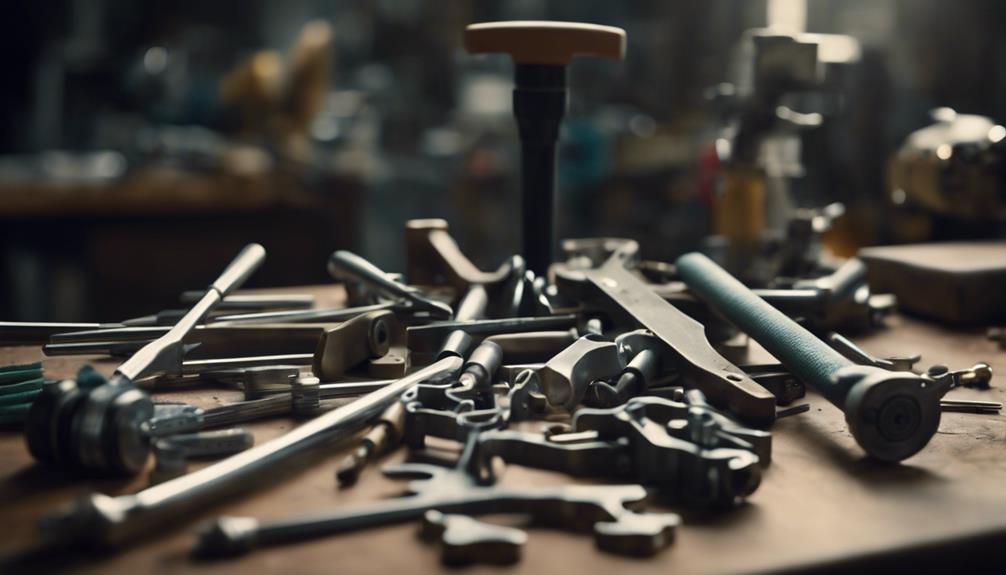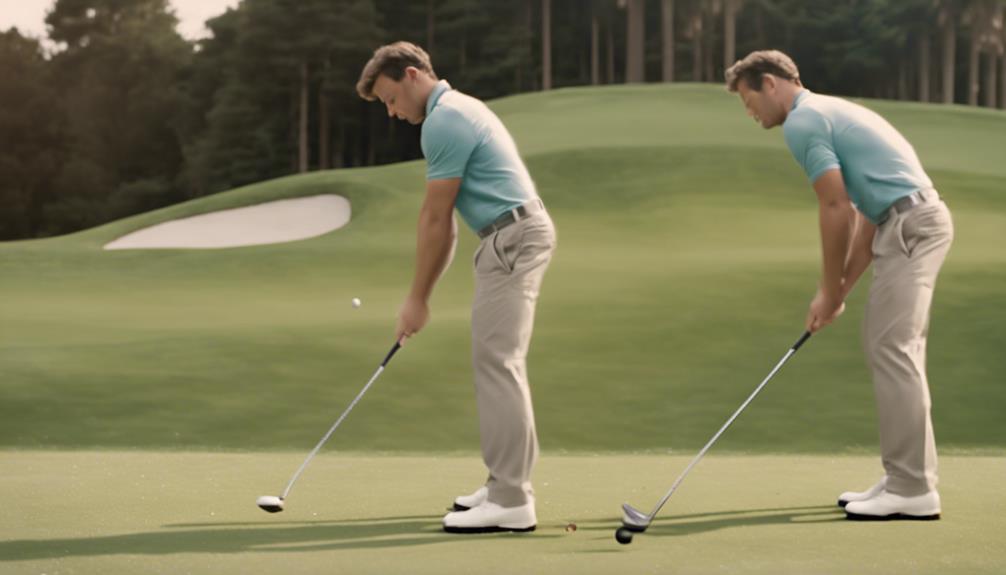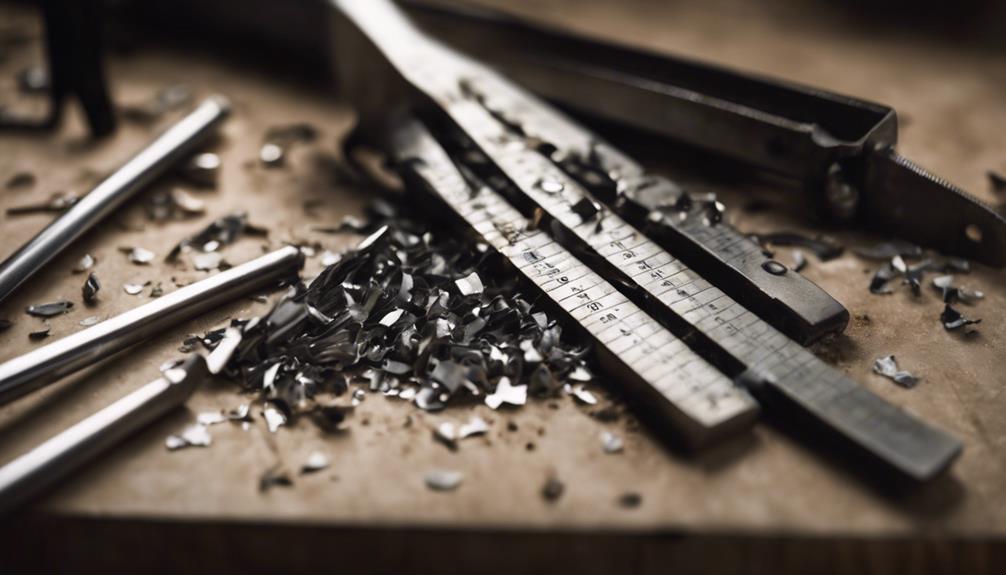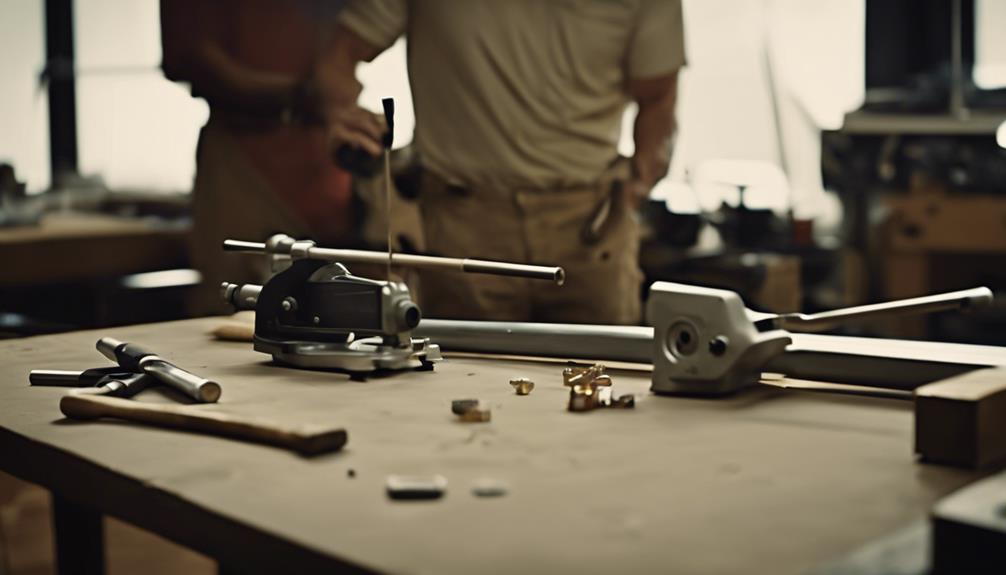- 7 Top Flite Golf Clubs XL for Improved Performance - September 28, 2024
- Top Flite Golf Clubs: Top 5 Reasons to Choose Them - September 28, 2024
- Top 3 Golf Club Fitters for a Perfect Swing - September 28, 2024
To shorten golf club shafts for a better fit, start by accurately measuring your wrist-to-floor length, as this dimension directly affects the ideal shaft length. Consider your height, arm length, swing style, and club head speed to determine the perfect length. Gather necessary tools, including a pipe cutter or hack saw, and clean the shaft before marking and cutting it. Remove excess material, deburr the edge, and rebalance the club. Be cautious of common mistakes, such as improper trimming or failing to reattach the clubhead securely. By following these steps, you'll be well on your way to customizing your golf club setup – and achieving improved performance and control.
Key Takeaways
- Measure the shaft length from the wrist crease to the floor to determine the ideal length for your swing style and posture.
- Consider swing tempo, ball flight, and overall performance to identify the optimal shaft length for your game.
- Use specialized tools like a pipe cutter, hack saw, or diamond-coated shaft trimmer to accurately cut the shaft to the desired length.
- Precise measurement and cutting are crucial to avoid affecting the shaft's integrity and compromising club stability and performance.
- After shortening, rebalance the club to ensure consistent performance and swing rhythm, and inspect the shaft for damage or defects.
Measuring for the Perfect Fit
When measuring for the perfect fit, you'll need to factor in a combination of physical characteristics, including your swing speed, tempo, and style, as well as your height, wrist-to-floor measurement, and other key factors.
To ensure an accurate measurement, stand upright with your feet shoulder-width apart and your arms relaxed by your sides. The measurement should be taken from the wrist crease to the floor, providing a precise indication of your shaft length requirements.
Your wrist-to-floor measurement is a more accurate indicator of shaft length than your height, as it takes into account the length of your arms and hands.
This is crucial, as a proper fit can significantly impact your game. By considering these factors, you'll be able to determine the ideal shaft length for your unique physique and swing style.
Choosing the Right Shaft Length
When choosing the right shaft length, you'll need to take into account several key factors that impact your game.
You'll want to think about your swing style, posture, and hand position, as these can all affect the ideal length of your shaft.
Shaft Length Factors
Considering your swing tempo, ball flight, and overall performance, you need to identify the ideal shaft length that optimizes your game.
A shaft that's too long can result in a loss of control and accuracy, while one that's too short can lead to a lack of power and distance.
To find the perfect shaft length, weigh your height, arm length, and swing style. Taller golfers with longer arms may benefit from longer shafts, while shorter golfers with shorter arms may prefer shorter shafts.
Additionally, golfers with faster swing tempos may require shorter shafts to maintain control, while those with slower tempos may benefit from longer shafts to generate more power.
When evaluating shaft length, bear in mind the entire club, not just the shaft. The club head, grip, and overall weight distribution all impact the club's performance.
By analyzing these factors and testing different shaft lengths, you can discover the ideal shaft length that suits your unique swing characteristics and playing style.
Club Head Speed Impact
As you test different shaft lengths, your club head speed – a critical factor in determining the ideal shaft length – plays a significant role in achieving peak performance.
Faster club head speeds require shorter shafts, as they allow for more control and precision. Conversely, slower club head speeds benefit from longer shafts, which generate more power and distance.
To determine the perfect shaft length for your swing, consider your club head speed in relation to your swing tempo and style.
If you have a fast tempo and high club head speed, you'll likely benefit from shorter shafts. Conversely, if you have a slower tempo and lower club head speed, longer shafts may be more suitable.
When testing shaft lengths, pay attention to how the club feels in your hands.
Do you feel more in control with a shorter shaft, or do you generate more power with a longer one?
Tools and Supplies Needed

Now that you've determined the ideal shaft length, it's time to gather the necessary tools and supplies to shorten your golf club shafts.
You'll need shaft measuring tools to verify accuracy, and club fitting supplies to guarantee a seamless installation.
With the right tools, you'll be able to achieve a precise cut and a smooth grip installation.
Shaft Measuring Tools
You'll need a precise set of tools to accurately measure and cut your golf club shafts, including a pipe cutter, hack saw, vise, cut-off wheel, sanding belts, and sandpaper.
A pipe cutter is necessary for cutting steel shafts, but not required for graphite shafts.
A hack saw and vise can be used as alternative tools for cutting golf shafts, especially for those who don't have a pipe cutter.
A cut-off wheel provides a clean and precise cut.
Sanding belts or sandpaper are essential for deburring the cut edge of steel shafts to facilitate a smooth grip installation.
Club Fitting Supplies
What tools and supplies do you need to facilitate a precise and professional-quality club fitting when shortening golf club shafts? To guarantee a successful and accurate process, you'll require a range of specialized tools and supplies.
| Tool/Supply | Purpose | Type of Shaft |
|---|---|---|
| Pipe Cutter | Cutting steel shafts | Steel |
| Hack Saw and Vise | Cutting steel and graphite shafts | Steel, Graphite |
| Cut-Off Wheel | Cutting graphite shafts | Graphite |
| Sanding Belts/Sandpaper | Deburring steel shafts | Steel |
In addition to these essential tools, a jig or fixture can be manufactured or purchased to help with the cutting process, especially for DIY golfers who plan to shorten multiple shafts. Accurate measuring and marking of the shaft are also vital, and using a ruler or caliper can help facilitate precise measurements. Don't forget to have lead tape on hand to adjust the weight and balance of your clubs after shortening. With these tools and supplies, you'll be well-equipped to achieve a professional-quality club fitting that suits your unique swing style.
The Shortening Process Explained
Take precise measurements of your original shaft length and swing weight to determine the key shortening point, as this crucial step sets the stage for a successful modification. This confirms that you accurately identify the ideal length for your swing style and body type.
Next, you'll prepare the shaft for cutting. This involves cleaning the shaft to remove any dirt, oil, or wax that may interfere with the cutting process. Then, you'll mark the shaft at the determined shortening point using a marker or tape.
Cutting the shaft: Use a shaft cutter or a high-speed saw to carefully cut the shaft at the marked point.
Removing excess material: Use a shaft scraper or sandpaper to remove any excess material or burrs created during the cutting process.
Inspecting and refining: Inspect the shaft for any imperfections and refine it to guarantee a smooth, even surface.
Reinstalling components: Reinstall the clubhead, grip, and any other components, guaranteeing they're properly aligned and secured.
Common Mistakes to Avoid

After successfully shortening your golf club shaft, it's equally important to be aware of common mistakes that can undermine the modification's effectiveness.
One of the most critical mistakes to avoid is improper trimming of the shaft. When trimming the shaft, you must guarantee that the cut is clean and precise, as a rough or uneven cut can affect the shaft's integrity and lead to inconsistent performance.
Another mistake isn't properly reattaching the clubhead, which can result in loose connections and compromised club stability.
Additionally, failing to rebalance the club after shortening the shaft can greatly impact your swing. You must recalibrate the club's weight and MOI to maintain peak performance.
Moreover, neglecting to inspect the shaft for any damage or defects before shortening can lead to catastrophic failures during play.
Professional Fitting and Assembly
Once you've successfully shortened your golf club shaft, you'll need to entrust a professional fitter to assemble the club, providing a precise fit that aligns with your unique swing characteristics. This vital step requires expertise and attention to detail to guarantee peak performance.
A professional fitter will assess your swing dynamics, taking into account factors such as your stance, grip, and swing tempo.
Precise shaft alignment: The fitter will verify the shaft is properly aligned with the clubhead, resulting in consistent ball striking and reduced dispersion.
Customized lie and loft adjustments: The fitter will make adjustments to the clubhead's lie and loft to accommodate your individual swing characteristics, promoting a more consistent and controlled swing.
Proper weight distribution: The fitter will balance the club to maximize weight distribution, allowing for a smoother, more efficient swing.
Thorough quality control: The fitter will conduct a series of tests to confirm the club meets the highest standards of quality and performance.
Shaft Trimming Techniques

When trimming a golf club shaft, you'll need to employ precise cutting techniques to avoid damaging the shaft's integrity, maintaining a clean, accurate cut that preserves the shaft's original specifications. To achieve this, you'll need to choose the right cutting tool and method. There are three common methods to cut the shaft: cutting with a shaft cutter, using a hacksaw, or employing a diamond-coated shaft trimmer.
Here's a comparison of these methods:
| Method | Advantages | Disadvantages |
|---|---|---|
| Shaft Cutter | Fast, precise cuts | Limited to specific shaft sizes |
| Hacksaw | Inexpensive, versatile | Risk of damaging shaft, slow process |
| Diamond-Coated Trimmer | Accurate, clean cuts, flexible | Expensive, requires skill |
When deciding on a method, consider the type of shaft, the desired level of precision, and your personal skill level. Regardless of the method, make sure to measure carefully and mark the shaft accurately before cutting. Remember to always follow safety guidelines and take your time to achieve a precise cut that maintains the shaft's original specifications.
How Shortening Affects Club Performance
By mastering the art of shaft trimming, you can now turn your attention to understanding how shortening a golf club shaft affects its overall performance, as the changes can be subtle yet significant.
Shortening a shaft has a profound impact on the club's characteristics, influencing how it feels and performs in your hands.
Swing weight reduction: Shortening by 1 inch reduces the swing weight by approximately 6 points, making the club feel lighter to swing.
Stiffness and flex profile changes: The shaft becomes slightly stiffer, but the flex profile changes, making it more flexible by a whole category.
Distance and control implications: The loss of height affects the distance the ball can be hit, and the club's overall behavior will change, potentially affecting control and performance.
MOI and CG shifts: Shortening reduces the overall club weight and swing weight, affecting swing rhythm and tempo, and alters the shaft's moment of inertia (MOI), potentially impacting shot accuracy, while also changing the center of gravity (CG) of the club.
Customizing Your Golf Club Setup

When customizing your golf club setup, you'll need to weigh three key factors: club length options, lie angle adjustments, and swing style considerations.
You'll want to experiment with different lengths to find the perfect fit for your swing, and adjust the lie angle to achieve a consistent ball strike.
Club Length Options
You have several club length options to ponder when customizing your golf club setup, each with its unique benefits and trade-offs. When deciding on the ideal club length, you'll need to weigh factors such as your swing characteristics, height, and playing style.
Standard Length: This is the most common club length, suitable for golfers of average height and swing tempo. It provides a good balance between distance and control.
Shorter Length: Shortening your club shaft can result in a more controlled and consistent swing, particularly beneficial for golfers who struggle with accuracy. However, it may come at the cost of slightly reduced distance.
Longer Length: Lengthening your club shaft can increase distance, but may compromise control and consistency.
Custom Length: Through shaft shortening or lengthening, you can experiment with different club lengths to find the perfect fit for your unique swing. This process may require adjustments to the lie and weight of the club to achieve ideal performance.
Lie Angle Adjustments
Adjust the lie angle of your golf club to optimize its performance, as a mismatch between the club's lie and your swing plane can result in inconsistent ball flight and direction.
A lie angle that's too upright or too flat will cause the clubface to close or open, leading to wayward shots.
To get it right, you'll need to assess your swing plane and determine the ideal lie angle for your clubs.
Generally, golfers with a more vertical swing plane require a more upright lie angle, while those with a shallower swing plane benefit from a flatter lie angle.
When adjusting the lie angle, keep in mind that small changes can have a significant impact on your game.
A change of just 1-2 degrees can make a big difference in the way the club interacts with the ball.
Work with a professional fitter or club maker to verify that your lie angle adjustments are precise and tailored to your unique swing characteristics.
Swing Style Considerations
Golfers with distinct swing styles, such as sweepers or diggers, require customized club setups to maximize their performance, as their unique swing paths and attack angles demand tailored club specifications.
Your swing style has a profound impact on how you interact with the club, and understanding its nuances is vital for a perfect fit.
When considering your swing style, keep the following factors in mind:
Sweepers: If you have a sweeping swing, you'll benefit from shorter shafts to reduce the clubhead's height at impact, promoting a cleaner strike.
Diggers: As a digger, you'll want slightly longer shafts to accommodate your steeper angle of attack, ensuring the clubhead doesn't dig into the ground.
Upright swings: If you have an upright swing, you may require slightly shorter shafts to compensate for the increased clubhead speed.
Shallow swings: Conversely, shallow swings may benefit from slightly longer shafts to maintain a consistent strike.
Tips for a Successful Shortening Job
To achieve a precise and damage-free shortening job, accurate measurement and marking of the shaft are necessary, as even slight miscalculations can result in costly mistakes, particularly when working with graphite shafts.
You'll want to make the shaft ready for cutting by verifying your measurements are spot on. Using the right tools and techniques, such as a pipe cutter or hack saw, is also important for a clean cut and to prevent damage to the shaft.
When cutting, get as close to the vise as possible to minimize the risk of error. Consider using a jig or fixture to help with the cutting process, especially if you're a DIY golfer.
After cutting, don't forget to deburr the shaft, especially for steel shafts, to facilitate a smooth grip installation and prevent damage to the grip or shaft.
Frequently Asked Questions
How Do I Make My Golf Shaft Shorter?
You can explore Grip Options to achieve a shorter shaft feel, considering smaller grip sizes or specialized grips designed for shorter shafts, which might eliminate the need for physical shortening, optimizing your swing dynamics.
Can Graphite Shafts Be Shortened?
You're wondering if graphite shafts can be shortened, but you should know that material limitations exist, requiring specialized techniques to avoid damaging the internal structure, which can affect performance and flex profile.
What Does Shortening a Shaft Do to Lie Angle?
"When you shorten a shaft, you'll notice a corresponding adjustment to the lie angle, requiring a Lie Adjustment to maintain a proper swing plane, as the clubhead's position relative to the ground changes, affecting ball flight and overall performance."
Can I Get My Shaft Shortened?
Before modifying your shaft, consider investing in Shaft Insurance to protect your investment against damage or breakage, providing peace of mind and financial security as you explore shortening options for a better fit.
Conclusion
As you walk away from the workbench, your freshly shortened golf clubs feel tailor-made to your swing, like a glove fitting snugly on your hand.
Remember, precision is key – a perfectly fitted club is the difference between a birdie and a bogey.
Don't be afraid to experiment and fine-tune your setup, but always keep a watchful eye on the specs.
With the right tools and a bit of patience, you'll be driving like a pro in no time, your clubs singing in harmony with your swing.




